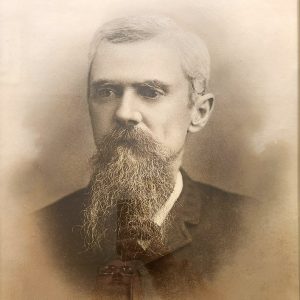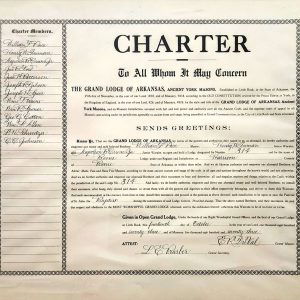calsfoundation@cals.org
William Fletcher Pace (1840–1912)
William Fletcher (W. F.) Pace was an officer in the Civil War, Boone County Clerk, and a prominent attorney in Harrison (Boone County) during the nineteenth and early twentieth centuries.
W. F. Pace was born on July 1, 1840, in Temple, Texas, to William Pace and Hester Armitage Pace. After his father died, Pace moved to Missouri with his mother when he was around age two. He grew up in Dent County, Missouri.
Pace was a Confederate in the Civil War. He began service in Dent County, Missouri, as a first lieutenant in Henry Pace’s Company, Fourth Cavalry Regiment, Seventh Division, Missouri State Guard. Henry Pace was Pace’s older brother.
On June 14, 1861, Pace enlisted in Company A, First Regiment, Seventh Brigade, of the Missouri State Guards (CS), commanded by James McBride. Pace was in the infantry. He fought in the Battle of Wilson’s Creek, Missouri, after which he was transferred to the brigade’s mounted rifles regiment. During a skirmish at Salem, Missouri, Pace’s left thigh was fractured. On August 10, 1862, he joined Company E, Eighth Missouri Infantry (CS), which was commanded by Colonel Charles S. Mitchell and was part of General D. M. Frost’s brigade. Pace was soon promoted to lieutenant of Company E and given command of this company. He resigned from this position to fight alongside Major General Sterling Price in Missouri, during which time he was wounded in the right shoulder, which ended his military service.
After the war, Pace lived in Harrison and was known by the moniker “Captain W. F. Pace.” Sources do not explicitly state why he was referred to as a captain. Possibly, when given command of Company E, Eighth Missouri Infantry (CS), his rank was temporarily elevated to captain; it may have been a brevet rank.
On August 21, 1866, Pace married Sarah Jane Howell. The couple had several children, including William Troy Pace, who became an attorney and assisted with the 1913 prosecution of Odus Davidson in Harrison for the 1912 murder of Ella Barham, and Frank Pace, whose son Frank Pace Jr. served as Secretary of the Army under President Harry S. Truman.
In 1870, Pace taught at private schools in Boone, Monroe, Sharp, and Woodruff counties. He was an advocate for the establishment of public education. He was also a merchant.
On October 14, 1873, Pace became the Charter Master of Harrison’s Lodge No. 314, Grand Lodge of Arkansas, Ancient York Masons.
From 1876 to 1878, Pace served as Boone County Clerk. He studied law and was admitted to the Arkansas Bar, the Arkansas Circuit Court, and the Bar of the United States Supreme Court in the early 1880s. He defended Charles (a.k.a. Andrew J.) Hudspeth, who was convicted of the 1886 murder of George Watkins in Marion County.
Pace was civic minded. In 1876, he was the master of ceremonies for Harrison’s Independence Day celebration. Incorporated the previous March, Harrison was celebrating both events. In 1898, before Harrison’s troop of soldiers departed to serve in the Spanish-American War, Pace acted as toastmaster during the town’s farewell banquet.
As a civilian, Pace was a Democrat and was known to enjoy poker and horse racing. He was involved in at least two gunfights. In the early 1870s, Jesse James’s gang robbed a mail carrier near Harrison. Pace and other men formed a posse to pursue the bandits, who were hiding in a log house. A shootout ensued, and Frank James shot Pace in the shoulder. In 1898, Monroe Aderholt threatened to kill any lawyer who defended his wife, with whom he was having domestic trouble. Pace was hired to defend her. Monroe found Pace in a Harrison bank and shot him, wounding him. A few days later, Pace’s sons unexpectedly encountered Monroe on the Harrison town square. Monroe began to draw his pistol. The boys, fearing for their safety, shot Monroe, killing him. One son stood trial and was found not guilty. Cases against the other two sons were continued and then dismissed. The incident became known locally as the Pace-Aderholt shooting.
During the winter of 1911–1912, Pace’s health declined. He became ill with asthma and bronchitis, followed by pneumonia, and died on August 31, 1912, at the Sisters of Mercy Hospital in Eureka Springs (Carroll County).
The Harrison Times in two articles from 1912 state that Pace was buried in Harrison on September 1, 1912. However, his gravestone and burial records indicate that he is buried in the Oakland & Fraternal Historic Cemetery Park, in the Pace family plot, in Little Rock (Pulaski County). Whether he was initially laid to rest in Harrison and later moved to Little Rock is unknown.
For additional information:
“Capt. W. F. Pace.” Confederate Veteran 21 (January 1913): 248. Online at https://babel.hathitrust.org/cgi/pt?id=njp.32101076522034&seq=1 (accessed April 18, 2024).
“Capt. W. F. Pace.” Harrison Times, September 7, 1912, p. 5.
“Convicted of Murder.” Yellville Mountain Echo, August 5, 1892, p. 1.
Gould, Nita. Remembering Ella: A 1912 Murder and Mystery in the Arkansas Ozarks. Little Rock: Butler Center Books, 2018.
Logan., Roger V., Jr. “Aderholt-Pace Gunfight 1898.” Boone County Historian 21 (October–December 1998): 76–80.
“Pace’s Side.” Springfield Leader and Press, January 6, 1899, p. 8.
Peterson, Richard C. Sterling Price’s Lieutenants: A Guide to the Officers and Organization of the Missouri State Guard 1861–1865. Shawnee Mission, KS: Two Trails Publishing, 1995.
Rea, Ralph R. Boone County and Its People. Van Buren, AR: Press Argus, 1955.
“Resolutions of the Harrison Bar Association on the Death of Captain W. F. Pace.” Harrison Times, September 14, 1912, p. 4.
Nita Gould
Tulsa, Oklahoma
 Law
Law Politics and Government
Politics and Government Post-Reconstruction through the Gilded Age, 1875 through 1900
Post-Reconstruction through the Gilded Age, 1875 through 1900 William F. Pace
William F. Pace  Lodge 314 Charter
Lodge 314 Charter 



Comments
No comments on this entry yet.